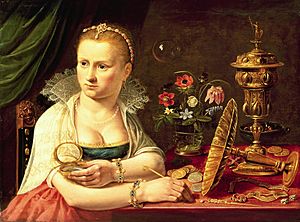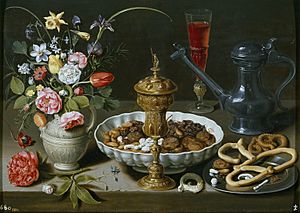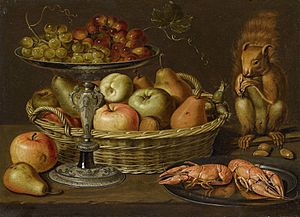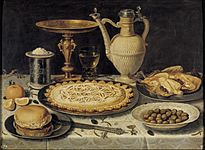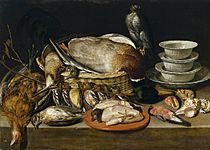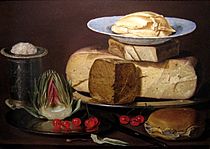Clara Peeters facts for kids
Clara Peeters was a talented Flemish artist who painted still-life pictures. She was active between 1607 and 1621. Clara worked in both the Spanish Netherlands and the Dutch Republic, which are parts of modern-day Belgium and the Netherlands.
Clara Peeters is one of the most famous female Flemish artists from her time. She was one of the few women who worked as a professional artist in the 1600s. This was special because it was hard for women to get art training or join art guilds back then. Clara was known for her still-life paintings, especially those with food. She helped create the style of "breakfast pieces" (called ontbijtjes) and "banquet pieces" (called banketjes). These paintings showed food, simple dishes, and sometimes expensive cups made of precious metals.
Contents
Life of Clara Peeters
We don't know many details about Clara Peeters' life. Most experts agree that she was from Antwerp. Records in Antwerp show a Clara Peeters, daughter of Jean (Jan) Peeters, was baptized on May 15, 1594. This happened at the Church of St. Walburga in Antwerp.
Another record shows a marriage between a Clara Peeters and Henricus Joosen on May 31, 1639, in the same church. However, "Clara" and "Peeters" were common names in Antwerp. If she was born in 1594, her paintings from 1607 would mean she was only 12 or 13 years old when she made them. Some experts think she was born earlier, perhaps in the 1580s, because her early works look very skilled.
By 1611, Peeters was working in Amsterdam. She was also recorded in The Hague in 1617. We don't see any of her paintings after 1621. Some people think she might have stopped painting after she got married, like artist Judith Leyster did. Many copies of her work exist, made by different artists. This makes some people think she might have had a small art school. We don't know when Clara Peeters died. Experts have guessed different dates, but none are certain.
How Clara Peeters Learned to Paint
Clara Peeters' first known painting is signed and dated 1607. This painting shows that she was already a very skilled artist. Her painting style suggests she learned her craft in Antwerp. Antwerp was an important center for still-life painting early on.
Most artists and their students were listed in the records of the local Guild of Saint Luke. But there are no records of Peeters in Antwerp or other art centers. Some experts think she might have been the daughter of a painter. If so, she might not have needed to be listed in the apprenticeship records.
Many experts believe her work looks a lot like that of Osias Beert. They think he might have been her teacher. Beert started his career as a still-life painter in 1602. She has also been linked to other Antwerp artists like Hans van Essen and Jan van der Beeck. Some also suggest Jan Brueghel the Elder as a possible teacher.
Even though she wasn't in the guild's records, at least one of Peeters' paintings has the stamp of the Antwerp Guild on its back. This means she might have been a member, or at least used art panels made by guild members.
Clara Peeters' Artworks
Clara Peeters signed 31 of her works with "CLARA PEETERS" or "CLARA P." She also dated many of them. This gives us a clear record of her work from 1607 to 1621. Eighteen of these paintings were finished by the time she was just 18 years old. Experts also believe another 76 works might be hers, but there isn't enough proof to say for sure.
Several of her paintings, including two shown here, have her signature engraved on the handle of a decorated knife. This might have been a real knife she owned, or just one she imagined.
Peeters was one of the first artists to specialize in still lifes and flowers. She worked when this type of painting was still quite new. Before 1608, when she painted her first recorded work, fewer than ten paintings of flowers and fewer than five of food were made in the Netherlands.
She painted a set of four larger-than-usual still lifes, three dated 1611. These paintings were later part of the Spanish royal collection. They are now in the Prado museum. This set includes the earliest still-life painting of dead game birds. Her paintings of fish and game from 1611 appeared much earlier than similar works by other artists.
In her paintings before 1620, Peeters loved to show how light fell on metal objects. She painted coins, goblets, and pewter dishes, showing their reflections. She even painted herself in the reflections of goblets and gold cups in many of her paintings. This was a common art trick in the Netherlands for over a century.
Experts think that Peeters might have run her own art workshop. This is because she often used the same objects in her paintings, and some works show different levels of quality. She might have had students help her paint these repeated objects.
Who Bought Her Paintings?
We don't have records of who bought Clara Peeters' paintings. But it seems she was a successful artist. Many things about her paintings suggest they were made for rich collectors. Her paintings were often large and showed expensive items from that time.
Four of Peeters' early works came to the Prado museum from the Spanish royal collection. One of her paintings was listed in a collection in 1627. Another was listed in a document from a notary in 1628. This shows that her art was valued by important people.
Images for kids
-
Table with Orange, Olives and Pie, probably 1611, with the "signed knife", from the Prado set
-
1611, from the Prado set. This is thought to be the first still-life of dead game birds.
See also
 In Spanish: Clara Peeters para niños
In Spanish: Clara Peeters para niños


